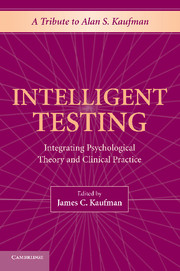Book contents
- Frontmatter
- Contents
- Acknowledgments
- Alphabetical List of Authors and Affiliations
- PART ONE THOSE WHO KNOW HIM
- PART TWO INTELLIGENT TESTING
- 4 Intelligent Testing: Bridging the Gap between Classical and Romantic Science in Assessment
- 5 The Intelligent Testing of Children with Specific Learning Disabilities
- 6 Temperament Preferences for Children Ages 8 Through 17 in a Nationally Represented Sample
- 7 Intelligent Intelligence Testing: The Influence of Alan S. Kaufman
- PART THREE THE INTERSECTION OF THEORY AND MEASUREMENT
- PART FOUR KAUFMAN ACROSS THE WORLD
- Author Index
- Subject Index
- References
7 - Intelligent Intelligence Testing: The Influence of Alan S. Kaufman
Published online by Cambridge University Press: 05 August 2012
- Frontmatter
- Contents
- Acknowledgments
- Alphabetical List of Authors and Affiliations
- PART ONE THOSE WHO KNOW HIM
- PART TWO INTELLIGENT TESTING
- 4 Intelligent Testing: Bridging the Gap between Classical and Romantic Science in Assessment
- 5 The Intelligent Testing of Children with Specific Learning Disabilities
- 6 Temperament Preferences for Children Ages 8 Through 17 in a Nationally Represented Sample
- 7 Intelligent Intelligence Testing: The Influence of Alan S. Kaufman
- PART THREE THE INTERSECTION OF THEORY AND MEASUREMENT
- PART FOUR KAUFMAN ACROSS THE WORLD
- Author Index
- Subject Index
- References
Summary
INTRODUCTION
As I walked up to the third floor of Aderhold Hall at the University of Georgia (UGA) that fall day to attend a special meeting arranged by my PhD advisor, I had no idea that the field of intellectual assessment was about to make a dramatic course change. Dr. Alan S. Kaufman was about to tell a group of doctoral students about the intention he and Nadeen Kaufman had to build a new intelligence test. This challenge to the venerable Wechsler and Binet empires was equivalent to the challenge that formed the basis of the movie The Mouse that Roared. The plot of the 1959 Cold War era satire went like this: The Duchy of Grand Fenwick decides that the only way to get out of the country's economic woes is to declare war on the United States, lose, and then accept foreign aid. (Alan told me how he memorized the entire dialog of this movie when working as an usher in a local movie theater.) In the end, through a series of unbelievable comic circumstances, the little country wins! The mouse did roar. So too did Alan and Nadeen Kaufman when they published the Kaufman Assessment Battery for Children (K-ABC) and the many tests that followed.
Alan and Nadeen mounted a charge that provided alternative intelligence tests and, in addition, new tests of many types through their students. None of us could imagine the eventual effect that was beginning that day.
- Type
- Chapter
- Information
- Intelligent TestingIntegrating Psychological Theory and Clinical Practice, pp. 73 - 96Publisher: Cambridge University PressPrint publication year: 2009



